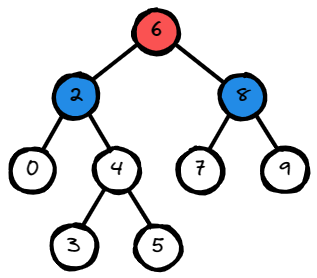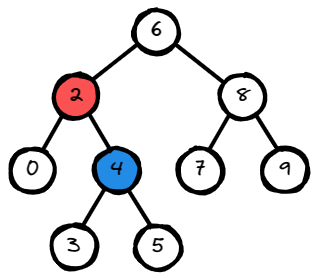Lowest Common Ancestor of a Binary Search Tree
Lowest Common Ancestor of a Binary Search Tree: Given a binary search tree (BST), find the lowest common ancestor (LCA) node of two given nodes in the BST.
The lowest common ancestor is defined between two nodes p and q as the lowest node in T that has both p and q as descendants (where we allow a node to be a descendant of itself).
Example 1:

Input: root = [6,2,8,0,4,7,9,null,null,3,5], p = 2, q = 8
Output: 6
Explanation: The LCA of nodes 2 and 8 is 6.
Example 2:

Input: root = [6,2,8,0,4,7,9,null,null,3,5], p = 2, q = 4
Output: 2
Explanation: The LCA of nodes 2 and 4 is 2, since
a node can be a descendant of itself according to the LCA definition.
Example 3:
Input: root = [2,1], p = 2, q = 1
Output: 2
Constraints:
- The number of nodes in the tree is in the range
[2, 10^5]. -10^9 <= Node.val <= 10^9- All
Node.valare unique. p != qpandqwill exist in the BST.
Try this Problem on your own or check similar problems:
Solution:
- Java
- JavaScript
- Python
- C++
public TreeNode lowestCommonAncestor(TreeNode root, TreeNode p, TreeNode q) {
if(root.val > p.val && root.val > q.val) return lowestCommonAncestor(root.left, p, q);
else if(root.val < p.val && root.val < q.val) return lowestCommonAncestor(root.right, p, q);
return root;
}
/**
* Definition for a binary tree node.
* function TreeNode(val) {
* this.val = val;
* this.left = this.right = null;
* }
*/
/**
* @param {TreeNode} root
* @param {TreeNode} p
* @param {TreeNode} q
* @return {TreeNode}
*/
var lowestCommonAncestor = function (root, p, q) {
if (root.val > p.val && root.val > q.val) {
return lowestCommonAncestor(root.left, p, q);
} else if (root.val < p.val && root.val < q.val) {
return lowestCommonAncestor(root.right, p, q);
} else {
return root;
}
};
# Definition for a binary tree node.
# class TreeNode:
# def __init__(self, x):
# self.val = x
# self.left = None
# self.right = None
class Solution:
def lowestCommonAncestor(self, root: 'TreeNode', p: 'TreeNode', q: 'TreeNode') -> 'TreeNode':
if root.val > p.val and root.val > q.val:
return self.lowestCommonAncestor(root.left, p, q)
elif root.val < p.val and root.val < q.val:
return self.lowestCommonAncestor(root.right, p, q)
else:
return root
/**
* Definition for a binary tree node.
* struct TreeNode {
* int val;
* TreeNode *left;
* TreeNode *right;
* TreeNode(int x) : val(x), left(NULL), right(NULL) {}
* };
*/
class Solution {
public:
TreeNode* lowestCommonAncestor(TreeNode* root, TreeNode* p, TreeNode* q) {
if (root->val > p->val && root->val > q->val)
return lowestCommonAncestor(root->left, p, q);
else if (root->val < p->val && root->val < q->val)
return lowestCommonAncestor(root->right, p, q);
else
return root;
}
};
Time/Space Complexity:
- Time Complexity: O(h) where
his the height of tree - Space Complexity: O(h)
Explanation:
We have a binary search tree where for each node n we have all nodes with smaller values in the left subtree, while all the nodes with larger values in the right subtree. To search in a BST, we spend at most log n = h = height of tree time and space (for recursion). We can utilize the property of BST to find the lowest common ancestor as we have three scenarios:
- The
root.valis larger than bothpandqso we can decrease it and go left (find nodes with smaller value) - The
root.valis smaller than bothpandqso we can increase it and go right (find nodes with larger value) - The
root.valis larger (or equal) than the value of one of the nodespandqand smaller (or equal) than value of the other, so we have found the common ancestor
Let's also transform the recursive version to the iterative one (saving on space complexity):
- Java
- JavaScript
- Python
- C++
public TreeNode lowestCommonAncestor(TreeNode root, TreeNode p, TreeNode q) {
while (root != null) {
if (root.val > p.val && root.val > q.val) {
root = root.left;
} else if (root.val < p.val && root.val < q.val) {
root = root.right;
} else {
return root;
}
}
return null;
}
/**
* Definition for a binary tree node.
* function TreeNode(val) {
* this.val = val;
* this.left = this.right = null;
* }
*/
/**
* @param {TreeNode} root
* @param {TreeNode} p
* @param {TreeNode} q
* @return {TreeNode}
*/
var lowestCommonAncestor = function (root, p, q) {
while (root) {
if (root.val > p.val && root.val > q.val) {
root = root.left;
} else if (root.val < p.val && root.val < q.val) {
root = root.right;
} else {
return root;
}
}
return null;
};
# Definition for a binary tree node.
# class TreeNode:
# def __init__(self, x):
# self.val = x
# self.left = None
# self.right = None
class Solution:
def lowestCommonAncestor(self, root: 'TreeNode', p: 'TreeNode', q: 'TreeNode') -> 'TreeNode':
while (root) {
if (root.val > p.val && root.val > q.val) {
root = root.left;
} else if (root.val < p.val && root.val < q.val) {
root = root.right;
} else {
return root;
}
}
return null;
/**
* Definition for a binary tree node.
* struct TreeNode {
* int val;
* TreeNode *left;
* TreeNode *right;
* TreeNode(int x) : val(x), left(NULL), right(NULL) {}
* };
*/
class Solution {
public:
TreeNode* lowestCommonAncestor(TreeNode* root, TreeNode* p, TreeNode* q) {
while (root) {
if (root.val > p.val && root.val > q.val) {
root = root.left;
} else if (root.val < p.val && root.val < q.val) {
root = root.right;
} else {
return root;
}
}
return null;
}
};